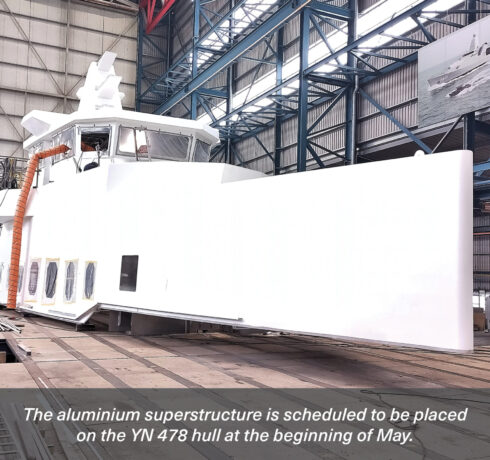A lot has happened on Damen Naval’s projects since the last update in February. The YN 478 hull is starting to take shape, “powerful” progress has been made on the Combat Support Ship and the end is approaching for the Colombia project, although there are high hopes for an extension and follow-up.
Summertime finish line in sight for YN 478 project for Damen Yachting
A visit to Production Hall 2 at Vlissingen-Oost shows that the YN 478 hull construction project has seen some substantial progress, passing some significant milestones, in the last few months. Damen Naval’s team has assembled the vessel’s bow section so that “it now definitely looks like a ship” says Stan Haag, the project’s Production Coordinator.
The amount of people working on outfitting jobs is also noticeable: “It’s getting very busy on board with pipe-fitters, steelworkers, painters and subcontractors,” Stan adds. “What is most spectacular is that we have been bringing in the big equipment into the engine room: the gearboxes and the main engines on either side. This is always an important milestone for a project, and we celebrated this together with Zeeuwse bolussen.”
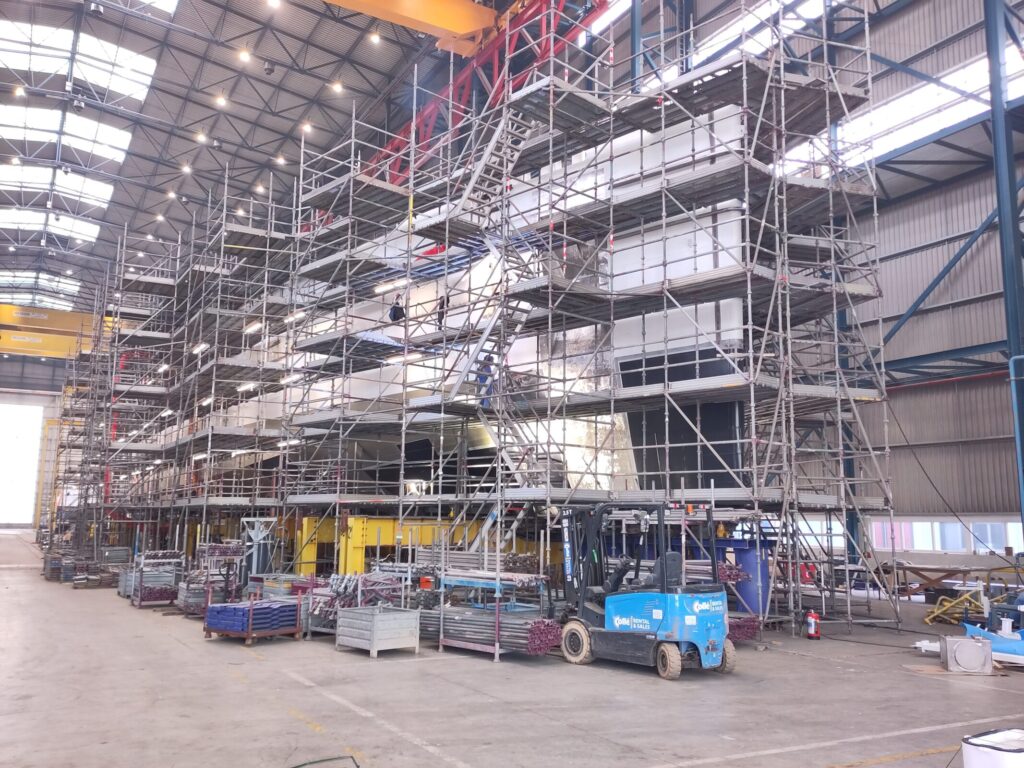 The YN 478 is taking shape – under that scaffolding you can see that the bow section has been assembled.
The YN 478 is taking shape – under that scaffolding you can see that the bow section has been assembled.
The section fabrication activities in Hall 1 are also running in top gear; the penultimate section is scheduled to go to the painting shed in mid-April and the final section before the end of April. “This is good news – it marks the end of section fabrication,” explains Stan.
The previous project update reported on the arrival of the three sections of aluminium superstructure from Bloemsma Aluminiumbouw in Makkum. “We are now getting ready to position the superstructure on top of the hull,” says Stan. The process of placing the superstructure on the hull has multiple steps, all based on the fact that the superstructure has 3.5cm of overlength. This overlength provides the crucial amount of leeway in the fine-tuning of this operation.
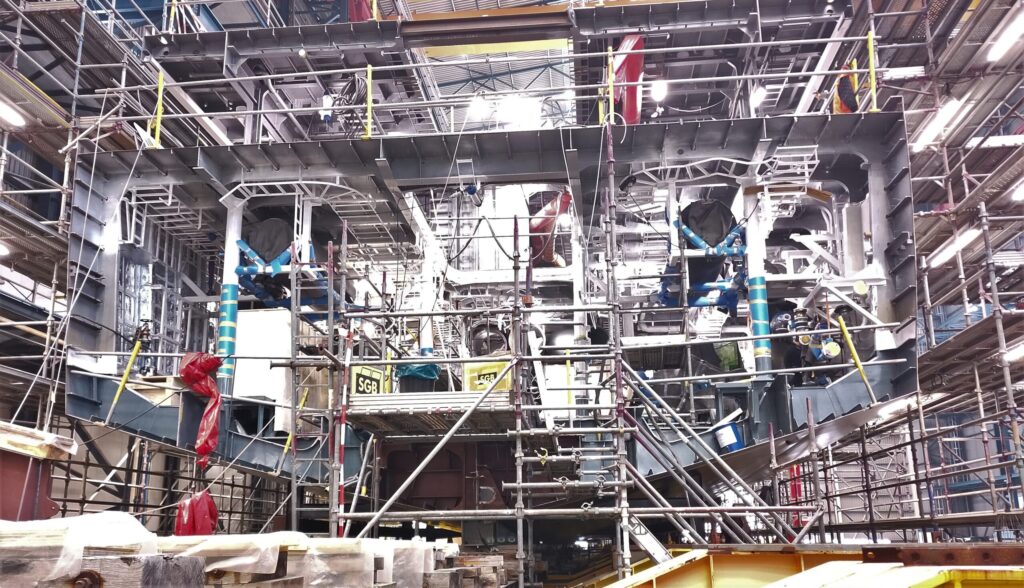 The engine room is still very much a work in progress, but now with the gearboxes and main engines in place.
The engine room is still very much a work in progress, but now with the gearboxes and main engines in place.
“After lifting the superstructure on to the hull, we will measure how much overlength there is along the length of the hull”, explains Stan. “Then we will lift the superstructure back up and remove the overlength where necessary – this is precision work that enables us to achieve the perfect fit before bringing the two parts back together for permanent welding.” To ensure the optimum structural integrity of the finished vessel, the aluminium superstructure will be welded to the steel hull using ‘triclad’ bimetallic strips.
Looking towards the months ahead, Stan is aiming to handover the production coordination role to Damen Yachting once Damen Naval’s hull assembly scope is complete. “This will be around mid-July. We are working hard as a team to achieve this and the conversations that we are having with our colleagues at Damen Yachting are very constructive. Everyone is working together to come up with smart and pragmatic solutions to any challenges we face – it is looking positive!”
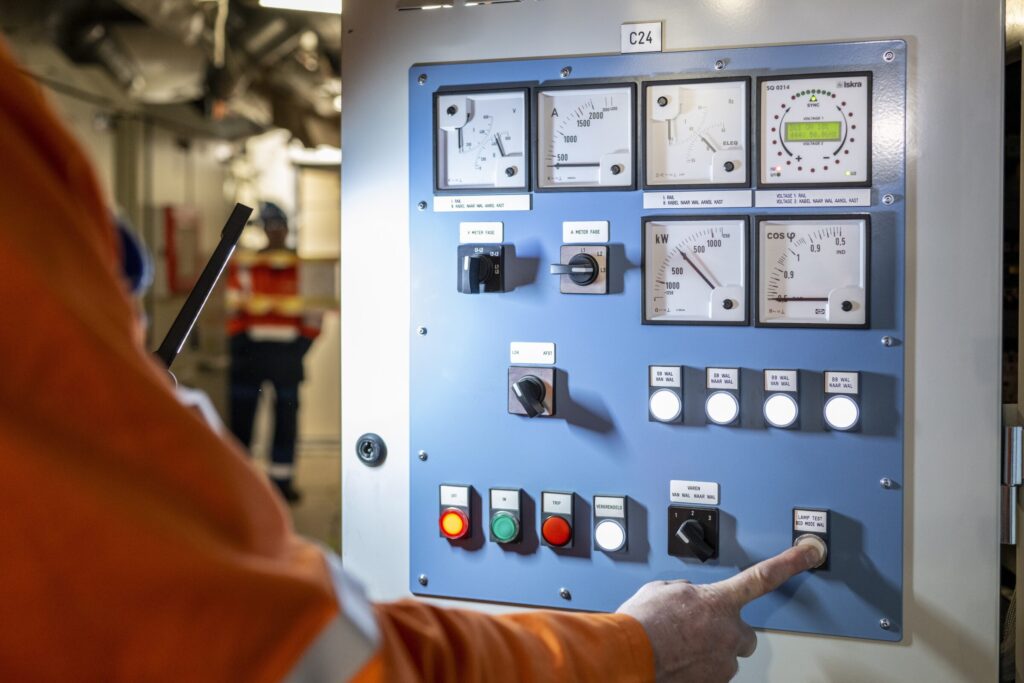 With the push of a button, the power was switched on aboard the Combat Support Ship.
With the push of a button, the power was switched on aboard the Combat Support Ship.
Combat Support Ship project powers up
Commissioning of the Combat Support Ship Den Helder has started in Galați, Romania, and the first step was to turn on the power on board. “The first time a new ship is connected to the shore connection boxes is always an exciting moment,” says Damen Naval’s Project Director Arjan Risseeuw. “Two of the four distribution switchboards on board are now powered from shore.”
On Tuesday 10 April, entirely according to schedule, the commissioning started. “Mission accomplished! It is an important milestone that we achieved on time,” Arjan says proudly. Now the task is to keep commissioning on schedule and that is a bit of a challenge as the team is still working on connecting the 780 kilometres of cable that will be incorporated into the ship. “Normally when you start commissioning, about 75% of the cables have been connected. We were at 25% on 10 April. We obviously don’t want commissioning to fall behind because not everything is connected, so there is quite a lot of pressure on the work.”
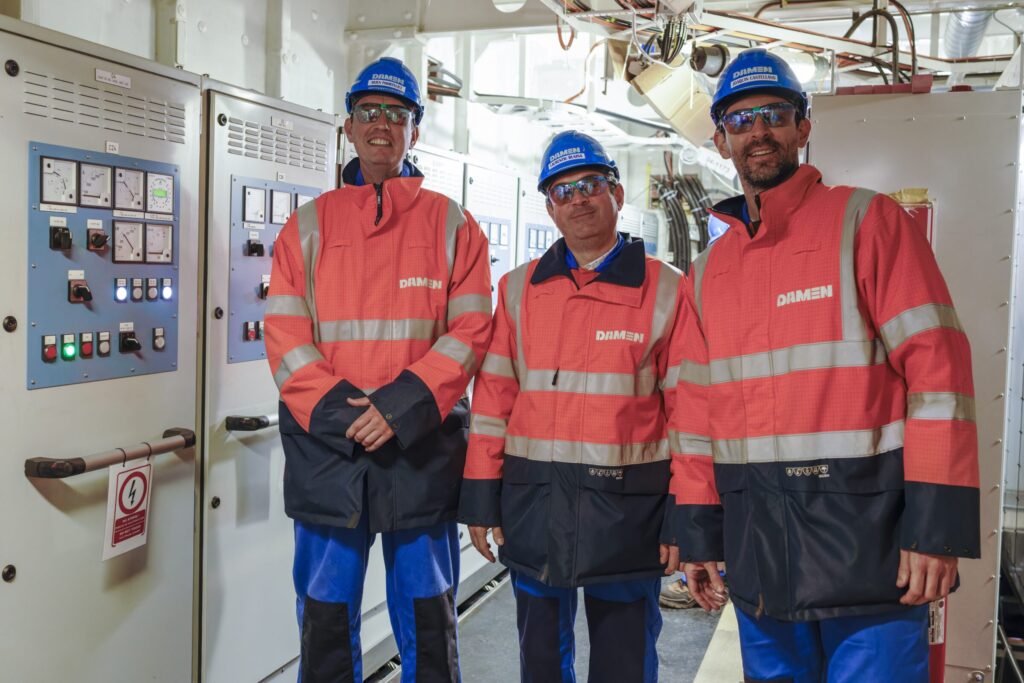 Commissioning began under the watchful eye of Arjen Poortvliet, Laurentiu Rugina and Joaquin Castellano.
Commissioning began under the watchful eye of Arjen Poortvliet, Laurentiu Rugina and Joaquin Castellano.
The ship under construction is still in the deep part of the dock but will be moved to the wharf at the yard on 29 April. “Right now, the alignment of the propeller shafts is being completed and when that is done, the mast can be installed,” says Arjan. “That is quite an task as well, as it is a complex, large mast. Once the mast is in place, it is secured by tack welding, and the ship leaves the dock. Once at the dock, the final welding will secure the mast properly.”
The commissioning also signals the start of a new phase of the project that required adjusting the safety level on board. “Certain systems on board are now live and that is dangerous. People working on board cannot just touch everything anymore. We adjusted our HSSE plan accordingly and informed everyone. Notifications have also been placed indicating which parts are live.”
In the coming months, the individual systems will be commissioned and once everything is working properly, the customer and classification society DNV will be invited for Harbour Acceptance Tests (HATs). The Dutch Ministry of Defence is also in the process of forming the start-up crew that will join the team on board during commissioning this year to get to know the ship as well as possible. You can read more about this in one of the next editions of Schelde Schakels.
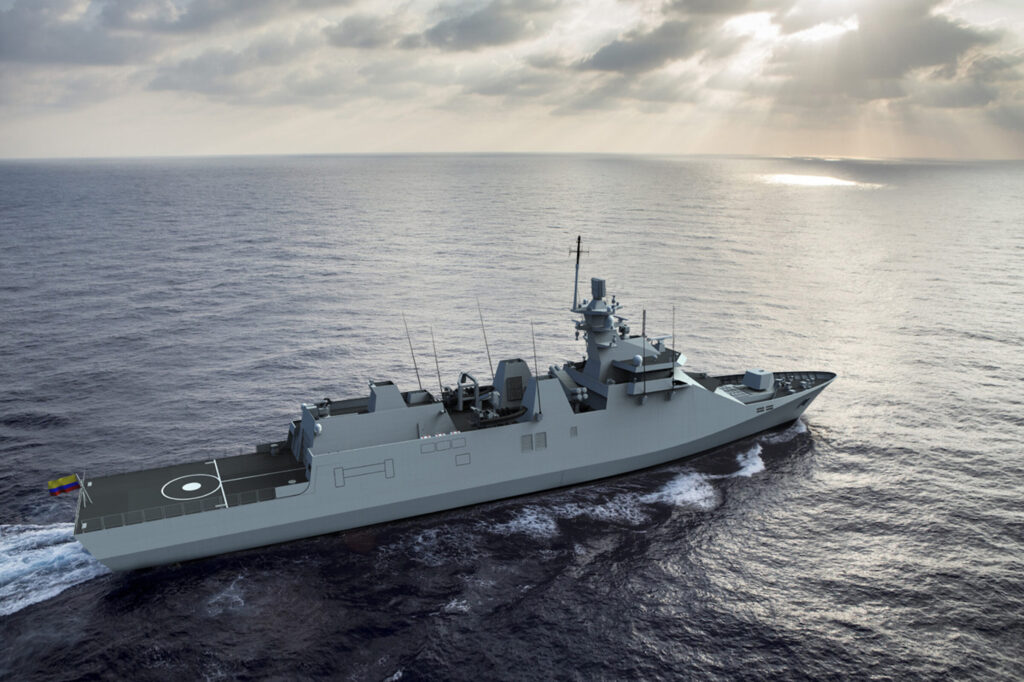 Damen Naval's design study for a new generation of frigates for Colombia is nearing its end.
Damen Naval's design study for a new generation of frigates for Colombia is nearing its end.
Colombia project enters final phase
Simon Delva’s team is entering an important phase of the project: on 31 May next, the last package of design documents will be delivered to the client COTECMAR. That means the design study with COTECMAR in which Colombia is investigating a new generation of frigates is nearing its end.
Now that the final phase has begun, work is also already underway on the follow-up: contract negotiations for a possible construction project. Simon: “The team is preparing a workable contract for the construction of the ship. So it remains exciting while we see how that will turn out.”
It has been an eventful few months. On 1 March, for instance, the second phase design documents were delivered. “Once again to the client’s satisfaction,” Simon says. “The whole team worked very hard on it, so then it is always nice to know that our efforts were well received.”
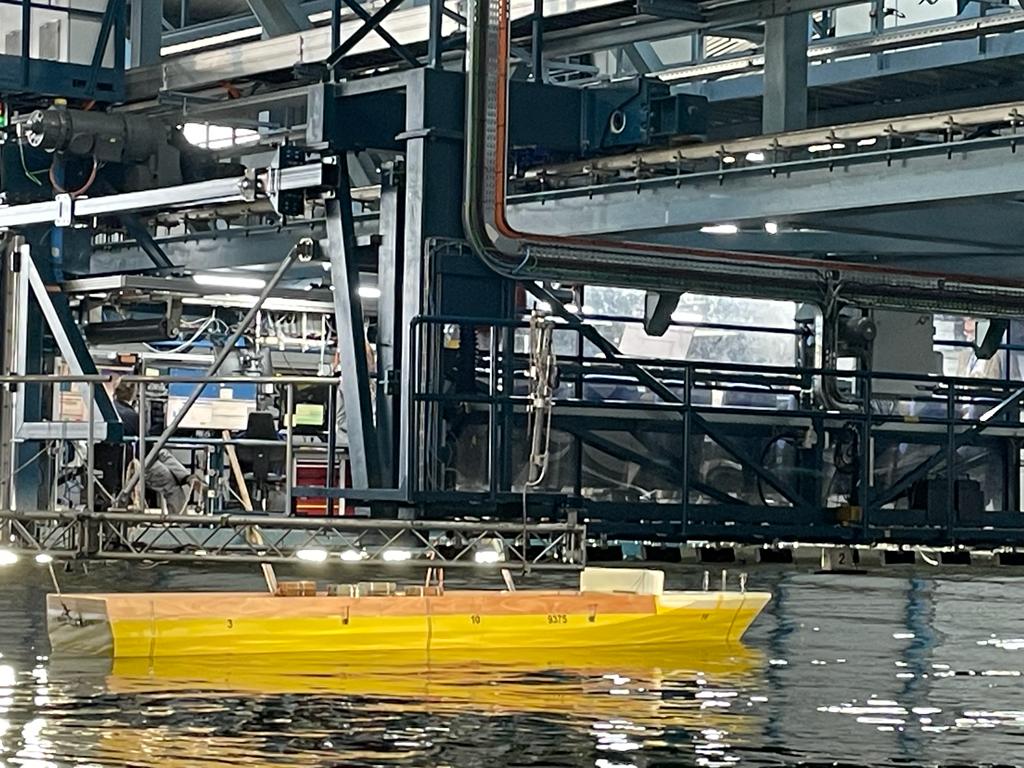 During their visit to the Netherlands, a Colombian delegation attended the model tests in Wageningen.
During their visit to the Netherlands, a Colombian delegation attended the model tests in Wageningen.
Last month, a delegation from Colombia also visited the Netherlands where they attended the model tests in Wageningen. Meetings were also held with the Damen Naval team on design decisions. “There are some difficult decisions to be made by the customer, so it was nice that we could meet them face-to-face to advise them,” Simon adds.
The results from the model tests at the Maritime Research Institute Netherlands (MARIN) in Wageningen (which you can read all about in the previous update) are expected in May. In parallel, an Approval in Principle (AIP) is ongoing. The ship design will be assessed by the external party Lloyd’s Register for compliance with so-called ‘naval rules’. These are rules specially drawn up for naval vessels for the purpose of classifying the ship.

